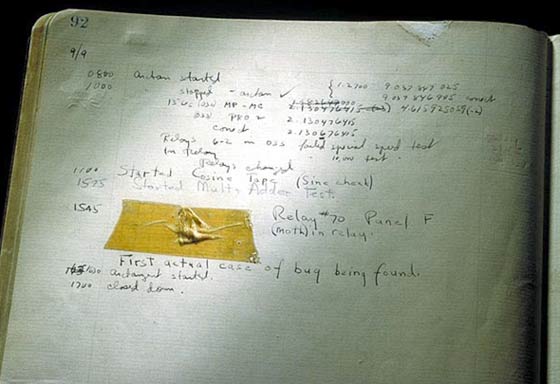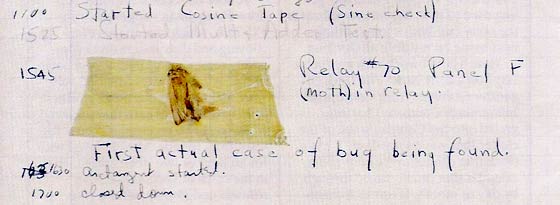On 9th September 1947 US Navy Rear Admiral Grace Murray Hopper was operating a ‘computer’, the Harvard University Mark II Aiken Relay Calculator. The machine was not working as it should and upon further investigation a ‘bug’ was found. In this case it was a moth, trapped in “Relay #70, Panel F”. This was the first documented computer bug.

Beaten to death
According to the Annals of the History of Computing Volume 3, Number 3, Admiral Hopper told her bug anecdote thus;
“It was a hot summer with no air conditioning, so all the windows were open. Mark II stopped, and we were trying to get her going. We finally found the relay that had failed. Inside the relay - and these were large relays - was a moth that had been beaten to death by the relay. We got a pair of tweezers. Very carefully we took the moth out of the relay, put it in the logbook, and put Scotch tape over it. Now, Commander Howard Aiken had a habit of coming into the room and saying “Are you making any numbers?” From then on if we weren’t making any numbers, we told him we were debugging the computer. To the best of my knowledge that’s where it started.”

Not the first bug
Engineers had used the term ‘bug’ long before to describe small errors or inaccuracies in electronics and machinery. It is recorded that the famous inventor Thomas Edison referred to bugs in electrical circuits in the 1870s. Also in WWII, almost the same era as the Harvard Mark II bug recording, radar glitches were often referred to as bugs. If the term bug wasn’t in prior use for machinery and electrical errors then the comment pencilled in below the Scotch taped bug: “First actual case of a bug being found” wouldn’t have made sense, or been a joke to anyone.
Etymologists can even trace the use of the word bug for “a fightful object; a walking spectre” as described in Samuel Johnson’s first dictionary much further back in history. It is with this meaning that it was used in Shakespeare’s Henry IV when King Edward says “So, lie thout there. Die though; and die our fear; For Warwick was a bug that fear'd us all.”
Read more about modern computer bugs here on HEXUS.













